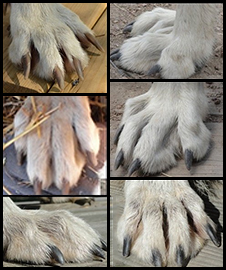

Opposite to humans, all canine species carry some degree of webbing on their paws. A similar process occurs in canines but to slightly less degree. Human fetuses have webbed digits up until about the 7th week of gestation.Īt that period, the cells that make up the webbing on the hands and feet die off. Moreover, some breeds have an addition – webbing between their toes.ĭid you know that all dogs start with webbed feet? In utero, webbed fingers and toes are common to all mammals. Their thick pads protect them from injury while their strong nails allow for traction on any kind of surface. In fact, canine feet were built with purpose. Just like in humans, their body parts have specific roles: dogs’ body parts also have a specific purpose. Just like in humans, the canine is the creation of their genetic materials. To understand better why this is the case, we need to think about genetic. Some dogs have webbed feet, while others have more regular paws. In this article, we will explore this view more and get to know breeds that are known for having webbed feet.
#WEBBED FEET DOGS SKIN#
Webbed feet mean that some breeds have extra skin between their toes.ĭog lovers will often tell you that great swimmers are breeds with webbed paws. The thing is that, Portuguese Water Dog has webbed feet, while Pomeranian doesn’t.

If your place is a home for many dogs of different breeds, such as Pomeranian and Portuguese Water Dog, you have probably noticed that their paws are different. If you insist on walks during the warm days you know that asphalt can harm your dog seriously, and put him into paw-related hell. If you clean your dog’s paws regularly and keep them healthy during the winter and harsh days, you know that paws are one of the most important parts of a dog’s body. So whether it’s digging, swimming, wet & soggy surfaces or uneven terrain, there are benefits of webbing.How well do you know your dog’s paws? Have you ever looked at a doggy’s paws? Like really looked? The majority of breeding with webbing has been assistance for swimming, even helping create ‘super-swimmers’ but breeds such as the Dachshund used the benefit of his webbing for digging because with webbing you can brush more dirt away faster when you’re digging around for small game. This is the same principle for Husky’s working on the snow, that the webbed toes result in greater weight distribution. Webbing came in handy for the Redbone Coonhound as he worked a lot in swampy or marshy areas, so his feet sank less. Have you checked to see if your dog has any between his or her toes? Below are breeds which have some degree of webbing.ĭogs with webbed feet have the ultimate flexibility when it comes locomotion on land or in water. Many animals (us too) have webbing as they are developing, then at some stage at a cellular level, this is turned off.ĭog breeds which worked around water had unique jobs and those such as the Newfoundland were often called upon for their brute strength, others with ‘less bulky’ bodies were used for tasks like herding fish into nets, carrying an item or message from one vessel to another or just retrieving smaller items fallen overboard. It’s taken a long line of ancestry to get to where they are now. Webbing is basically a membrane of connective tissue and skin. There are many features which make your dog’s feet unique including the toe placement, nail colour & length.


 0 kommentar(er)
0 kommentar(er)
